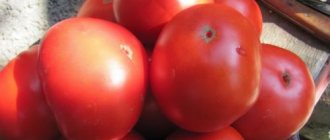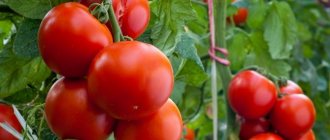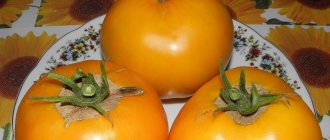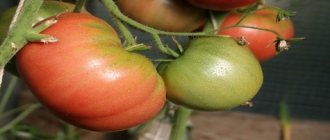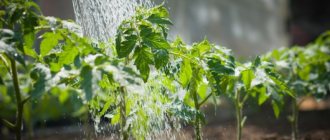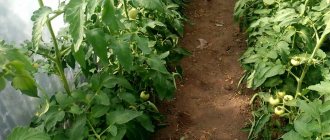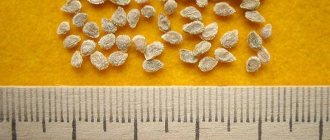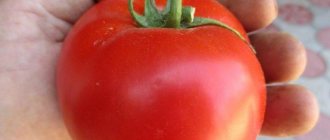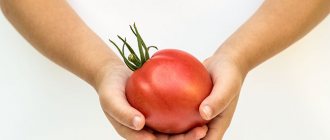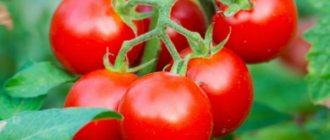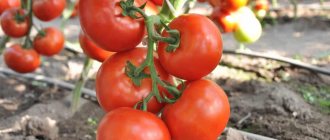Characteristics of tomatoes Irina
Mature Irina tomato bushes are tall; under good conditions they can grow up to 1-1.2 m or more. The plants are large, strong and stable, grow well in open ground and tolerate adverse weather conditions. The stem is thick, well leafy, and has several simple racemes.
The Irina tomato is distinguished by its high yield; up to 9 kg of tomato is harvested from one bush; from 1 sq. m – up to 18 kg. Plants begin to bear fruit in July, the yield period is long. When ripened, tomatoes acquire a regular round shape, slightly flattened on both sides. There is no green spot on the stalk. The harvest is well stored and transported.
Outdoor care
The Irina tomato has excellent performance, and therefore most gardeners speak very flatteringly about the results of their cultivation. However, they are the result of hard work while caring for this hybrid.
Watering
Features of watering tomatoes of the “Irina” variety:
- watering must be done directly on the ground (in no case should you pour the leaves, especially in strong sunshine);
- the water should not be too cold (preferably room temperature);
- Watering should be done as the soil dries out (every year the amount of watering can vary significantly).
Feeding
The first application of fertilizers should occur after the 25th day of bush growth. Any organic fertilizer (both store-bought and compost) is suitable as a top dressing; however, the amount of nitrogen that will enter the soil should be reduced. The total number of feedings during the growing season should not exceed 3. It is also important to pay attention to the fact that if there are few sunny days, you need to give more potassium.
You will be interested to know how to feed tomatoes with yeast.
Stepsoning
Pinching is the process of forming a bush by cutting off excess shoots. This is a mandatory procedure, because if it is not done, the bush will grow in all directions and will not produce a normal harvest. So, it is advisable to plant the Irina tomato into one, maximum two stems, and this must be done as soon as side shoots appear on the plants. Unnecessary shoots should be carefully trimmed. Thus, the bush will always look neat, and all its strength will go to the fruits, and not to the growth of shoots. In addition to removing green shoots, it is necessary to regularly cut off dried leaves and branches.
Soil care
Weeding is a mandatory daily procedure, along with loosening the soil and watering. After each watering, the soil must be loosened well to ensure even moisture ingress, and also to ensure that the soil does not crack or harden.
For additional protection from drying out, you can mulch tomatoes with pine needles, hay or peat. This will ensure good moisture retention in the ground, but the most rational way to obtain moisture is modern drip irrigation.
Important! As mentioned earlier, you need to think about the garter in advance, maintaining space between crops for installing supports.
Tying up a bush
Tying the bush must be done as it grows. This is done so that the heavy fruit does not break the branches with its weight and bend them to the ground. If this happens, you will not be able to get a rich, ripe fruit. There are many ways of tying, but many farmers continue to come up with more and more intricate designs for this purpose. However, the most common are the two simplest methods:
- garter on a thread (iron reinforcements are installed at the beginning and end of the beds, a dense thread is stretched between them across the entire bed, and the branches are tied to it);
- iron (wire) frames, which are installed directly next to each bush and serve as a reliable support for it.
Preventative treatment
The Irina tomato is considered a very resistant variety that is rarely susceptible to disease or pest attack. Because of this, there is no particular need to carry out any prevention. However, heavy rainfall can cause late blight. Therefore, in case of a large amount of rain, it is necessary to treat the bushes with Fitosporin, Trichopolum or a solution of wood ash a couple of times with an interval of 2-3 days. When insect pests appear, you should treat the bushes with a soap solution, and if this does not give results, only then resort to chemical insecticides.
Find out how to properly prepare a solution and treat tomatoes with iodine against late blight.
Pros and cons of the tomato variety Irina
The advantage of Irina tomatoes is their early ripening period, from germination to harvest it takes only 90 days. The plant is a determinate plant; it does not need to be pinched, limiting the top growth.
The seeds have excellent germination. When properly cared for, Irina tomato seedlings grow strong and tolerate transplantation into open ground well. The bushes have a powerful stem, develop intensively, and set fruit well. The harvest from 15 bushes is enough to provide tomatoes for a small family of three people. The Irina tomato variety has no disadvantages.
Harvesting and application
The fruits have a rich sweet taste. They contain about 3% sucrose and up to 6% dry matter. Tomatoes are characterized by their versatility in cooking: they are suitable for fresh consumption and the preparation of soups, sauces, tomato paste, juice, snacks, vegetable caviar, lecho, adjika. The thin but dense skin does not crack during heat treatment, which makes it possible to preserve tomatoes in a hot marinade.
The harvested crop tolerates transportation well over long distances, retains its taste and marketable appearance.
Optimal growing conditions
When growing in open ground, it is important to choose the right place for seedlings. Irina tomatoes, according to reviews, variety descriptions and photos, prefer fertile, light soil and good lighting. To protect against pests and diseases, preventive treatments with chemicals are carried out before flowering.
Advice! Proponents of natural farming can use biological insecticides and fungicides.
Growing in a greenhouse makes it easier to care for Irina tomatoes and allows you to harvest an earlier harvest. During the growing season, keep the soil under the bushes moderately moist and use mulch so that the moisture does not evaporate so quickly.
Seedling care
Seedlings are ready for planting at the age of 55-60 days, when warm weather sets in. By this time it is usually already blooming. 4 plants fit per square meter. Near the bushes you need to install supports and tie up the stems and fruits.
Watering is recommended abundant but infrequent. The soil is thoroughly moistened, and then the top layer is allowed to dry. Weeds are removed at intervals and the rows are loosened. Despite the strong immunity of the hybrid, the beds should be sprayed prophylactically with fungicides. Sometimes it is necessary to use insecticides to protect plants from harmful insects.
Plantings respond with gratitude to the application of fertilizers. It’s good if you can alternate organic with mineral ones. The first is an infusion of mullein or bird droppings, mown grass, and so on. During flowering and the formation of ovaries, there must be enough potassium in the soil, and phosphorus is needed for the formation of a branched and strong root system.
Another “secret” of growing is planning plantings taking into account the “correct” predecessors. Tomatoes turn out especially well after legumes, cabbage, and root vegetables have been grown in the beds. The soil is preferably fertile and light, with neutral acidity. Lime can be added to an acidic substrate for digging.
A mediocre variety according to the author in the video:
Agricultural technology tomato Irina
The Irina tomato is an intensive hybrid, responsive to good care. Agricultural technology includes regular weeding, watering, loosening and fertilizing. To maintain optimal soil moisture and protect against weeds, mulch the soil under the bushes or cover it with spunbond. To get a good harvest, special attention is paid to growing strong and healthy seedlings. Seedlings are ready for planting in open ground 50 days after emergence.
Growing seedlings
According to reviews and photos, tomatoes of the Irina variety grow well in open ground. To obtain strong seedlings, seeds are sown in late March or early April. Seedlings are germinated in peat tablets or store-bought universal peat-based soil. Dive 2 weeks after emergence.
Important! To obtain healthy seedlings, the soil is disinfected with Fitosporin. The seeds are treated in a weak solution of potassium permanganate.
If you have a heated greenhouse, you can start growing seedlings in mid-January. Additional lighting of the seedlings and maintaining optimal humidity and temperature will be required.
The order of sowing tomato seeds Irina:
- The seedling cassette is filled with universal peat substrate.
- Water, soaking the soil well.
- Place one seed in each cell of the cassette.
- Sprinkle the substrate on top to a height of about 5 mm.
- The air temperature is maintained at +25 °C.
- Cover the seed cassette with film to maintain moisture until germination.
- On the 3rd day, when the first shoots appear, the film is removed and additional lighting is turned on.
- The air temperature is reduced to +20 °C.
- The seedlings are illuminated with phytolamps from 5 to 22 o'clock. If it's cloudy outside, they don't turn off the lights during the day.
- Water as the soil dries.
- They dive in the phase of two true leaves, approximately 14 days after sowing in peat or plastic cups.
To prevent black leg, Irina tomato seedlings are kept warm, in good light, and not over-watered. If the stem is elongated, it can be buried into the soil when picking.
Landing rules
The soil on the site is prepared in the fall, filling with compost. It is important to observe crop rotation and not plant tomatoes in the same place for 2 years in a row. In the spring, the bed is dug up and complex fertilizers or vermicompost are applied. This will allow Irina tomatoes to quickly begin to grow and gain the necessary vegetative mass before flowering begins.
To ensure reliable survival of seedlings, they must be hardened a week before planting in open ground. Proper feeding is the key to normal growth and strong immunity of tomatoes Irina.
Advice! Seedlings are transplanted into open ground at the age of 45-55 days in the second or third decade of May.
Irina tomatoes are planted in holes or trenches at a distance of 25-30 cm between plants in a row, row spacing is 50 cm. If the soil is light and fertile, the root system can develop well in depth. When planting, add vermicompost or rotted compost to each hole.
To prevent the seedlings from breaking, the trunks are immediately tied to a support. With the first watering, Trichodermin or Fitosporin is added to cleanse the soil of pathogenic microorganisms. Mulch the tree trunk circle with neutral peat, straw or mown grass.
Watering and fertilizing
The first feeding of Irina tomatoes is carried out on the 5th day of life, as soon as the cotyledon leaves bloom. For this, 1 tbsp. l. dry vermicompost is diluted in 1 liter of clean water without chlorine, left for 24 hours and watered the seedlings. Every two weeks the tomatoes are fed with complex preparations. It is advisable to alternate mineral and organic fertilizers.
When growing tomatoes Irina f1 without fertilizing, judging by the photos and methods described in reviews of inexperienced gardeners, the yield decreases. A lack of potassium inhibits the synthesis of proteins in plant tissues, the growth rate slows down, and toxic nitrogen accumulates. It is advisable to add potassium and phosphorus to the fertilizer twice a month. For the first fertilizer, the amount recommended by the manufacturer is reduced by 3-4 times. Mix the preparation with vermicompost infusion and water the seedlings.
Important! Fertilizers must be used wisely; for example, if you overfeed tomatoes with potassium, chlorotic yellow spots will appear on the leaves.
For more intensive formation of ovaries, Irina tomatoes are treated with boric acid during flowering. To prepare the fertilizer, dissolve boric acid taken on the tip of a knife in 1 liter of hot water. Spray the tomatoes with a warm solution in the evening; there should be no burns on the leaves. It is also necessary to apply complex fertilizers containing phosphorus.
If the vegetative mass begins to turn pale during fruit filling, you can feed the plants with a store-bought solution of horse manure. The concentration is made two times less than indicated in the instructions. Apply fertilizer over wet soil during watering. When the fruits do not want to gain a juicy red color, you can feed the bushes with humic potassium leaf by leaf. Spraying is carried out in the evening.
Water the plants at the roots with water that has been left in the sun. The soil should not dry out or be excessively wet. The amount of moisture required depends on the structure of the soil. Light sandy soil will require daily watering in hot summers. Heavy clay soils will hold water longer.
Pinching and tying
According to the description and reviews of gardeners, the Irina tomatoes shown in the photo require a garter. The bushes are low and strong, but can break under the weight of ripening fruits. Large brushes are additionally tied to a support.
Pinching is carried out as the seedlings grow and side shoots develop. Excess branches are broken off by hand, leaving small stumps. It is advisable not to allow the stepsons to grow long; they take away from the plant the forces necessary for flowering and the formation of ovaries.
Formation
If plants are grown in short and cold summer conditions, they will be suitable for forming into a single stem. In the Southern regions, you can leave two stems by choosing the stepson under the first brush with flowers. Leaves that are in contact with the ground are also removed to prevent infection.
Protection from diseases and pests
During autumn digging, the biological preparation “Metarizin” is added to the soil against harmful insects. For nematodes, use “Aktofit”. During the growing season, marigold infusions are made and tomatoes are processed, since insect pests do not like these flowers. Every week, water the bushes with biological fungicides, wetting the leaves and soil - this will be a good prevention of fungal diseases.
Attention! Before flowering, diseased seedlings can be treated with insecticides - Actellik, Fufanon for insects or fungicides - copper sulfate, colloidal sulfur against various fungal infections.
Features of care
Determinate tomatoes do not require pinching, which makes the grower's work easier. But there is no need to relax. It is necessary to work hard to obtain the declared harvest.
- Loosening will provide oxygen access to the roots. Will help retain moisture in the soil longer.
- Watering is carried out in the morning and evening. It is advisable to use warm water. Ideally, organize drip irrigation.
- Fertilizing is alternated, organic matter and mineral fertilizers are used. Particularly paying attention to tomatoes during periods of budding, flowering, and ovary formation.
- Removing weeds will relieve plants from starvation. First of all, weeds draw out useful substances from the soil, and are also a place for pests to parasitize.
- Plants need staking. The height of the plant and the abundance of fruits require the installation of supports.
Even a novice vegetable grower can put these requirements into practice.
How to grow
Instructions on how to grow a bountiful harvest of these unique tomatoes are usually included on the seed packet.
Seedlings can be planted outside of a greenhouse. But if you cover it with film or a greenhouse, the fruits will be clearly larger. The bushes must germinate for at least a month before planting.
Tomatoes are planted in Chess order. It is worth making rows, maintaining a distance of 60-80 cm between them, and about 30 cm between seedlings. Stepchildren are removed gradually, about once a week, leaving several trunks with fruits.
See also
Characteristics and description of the Khlebosolny tomato variety, its yieldRead
After planting, the soil must be watered. Then once a week loosen the soil, feed and water. If the bush reaches a great length, then it is tied up.
